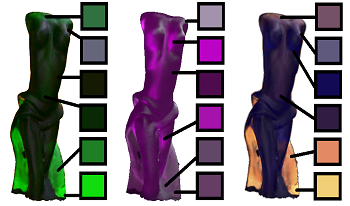
3-dimensional translucent objects exhibit large spatial variations of color, and it remains unclear what colors humans choose cognitively to represent monomaterial 3D translucent objects. Previous works asked human observers to match translucent object with a most representative uniform color patch. Matched colors were compared with the average color of the object, which turned out to be a poor predictor of the match. In this work, we conducted a more thorough analysis of the color matching experiments and investigated whether matched color is systematically overestimated or underestimated relative to the average color in any particular axis in the CIELAB space. Afterward, we conducted K-means clustering of the pixel colors to extract a palette of dominant colors of the translucent object and compare the palette with observers’ match. And finally, we went through a psychophysical experiment to quantify perceived color differences between pairs of 3D translucent objects. We explore whether perceptual color differences can be predicted with traditional color difference formulae using pixel-wise averages or dominant colors from the K-means clustering.